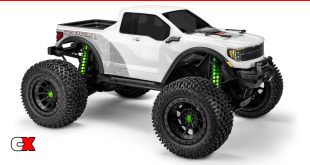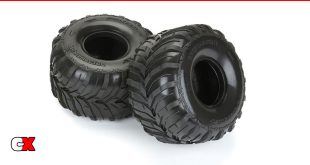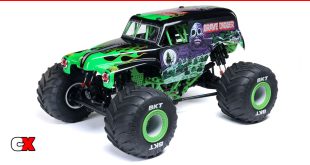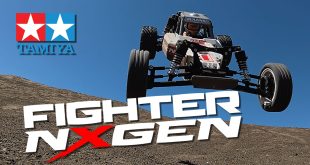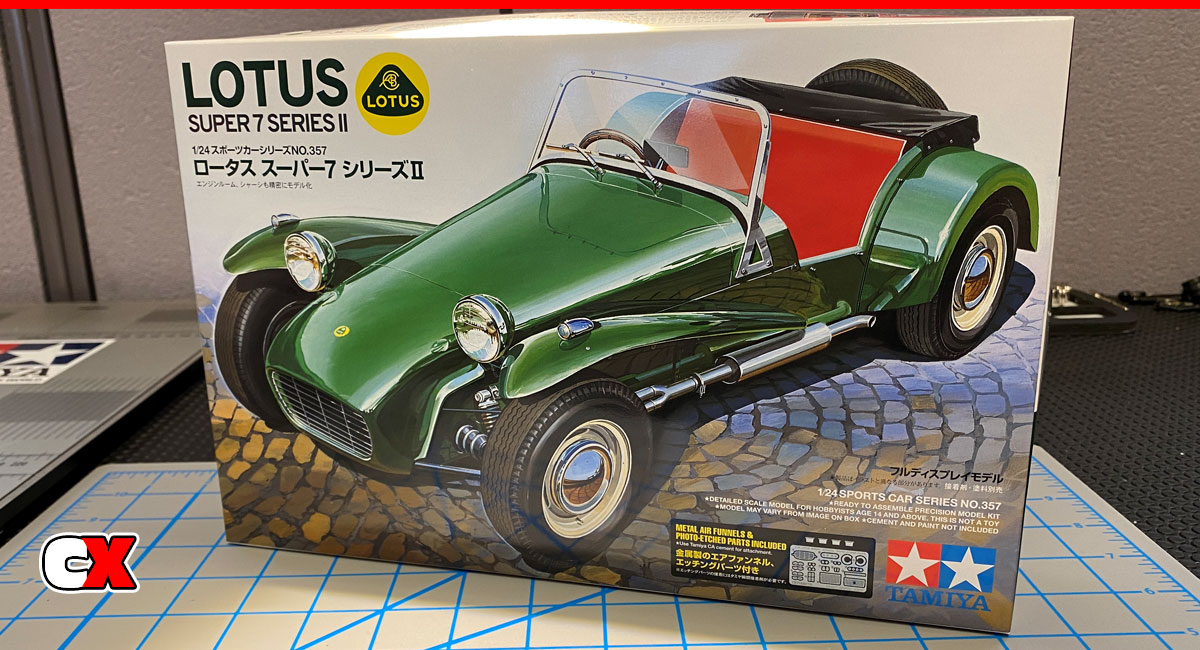
Well, we finally wrapped up the build of the Tamiya Lotus Super 7 Series II model kit. This is a very interesting car, in real life, and one that we had a chance to check out while in Europe some years ago. It’s always been a favorite with both my dad and I and, some day, we would love to own one.
However, for now, we’re happy to have a finalized 1/24 scale model kit of it.
This car can be built one of two ways, in either road or a race version. Or, if you’re like us, we went with a road version that had some race parts on it, a dailydriven race car, so to speak.
Ok, let’s get to the details.
Product: Tamiya Lotus Super 7 Series II
Website: www.tamiyausa.com
Purchase: https://bit.ly/3MD18rP
Part #: 24357
Scale: 1/24 Scale
Molded Colors: White, chrome, clear
Price: $27.20
Recommended For: Intermediate to Advanced builders
Unboxing Video
 Chassis
Chassis
The chassis on the Super 7 doesn’t include much – it’s basically flat panels that are integrated into the bodywork. There’s no frame rails, per se, so not much detail is included to show off. But, that’s the case with the real car and not a result of the actual Tamiya kit, so it is what it is. And, unfortunately, there’s only a little bit you can do as far as detailing. It is a challenge, as far as masking goes, but we love the fact that the appearance is a bunch of aluminum panels with some stuff bolted to them.
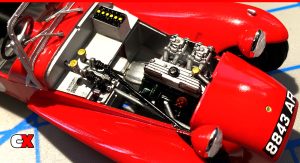 Engine
Engine
The engine in the kit is a nicely detailed rendition of the actual 1.3 liter, 4-cylinder Ford Cosworth powerplant. Even mounted in the lightweight, Super 7 shell, this engine only pushed the Lotus to about 100mph. In all honesty, it’s quite a puny engine when you take off the cowling to display it – something much bigger could have gone in it’s place (like a straight-6?). However, Tamiya did a great job in recreating the 4-cylinder, even in it’s slightly basic form. The only real glue-on parts are the fan belt assembly, valve cover, distributor and dual-carbs. Tamiya, did, though, add a nice set of photo-etched parts for the velocity stacks and mount. These are tricky to install (with ham-hands such as ours) but the final product looks awesome!
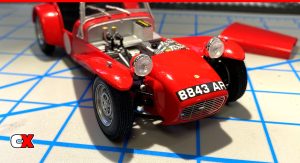 Suspension
Suspension
The suspension system on the Super 7 is pretty simple as well – upper and lower tube arms with shocks up front, solid axle with shocks out back. The nicely detailed front brake system also includes a set of photo-etched rotors, but only for the outer-facing side. Other than that, there are no anti-roll bars or other complex suspension bits, just the basics. This makes painting and assembly quite easy, however the actual assembly process is a delicate procedure (again, chubby-paw syndrome). Have a good set of tweezers and some patience handy to help make this process a bit easier.
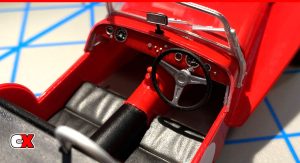 Interior
Interior
Like the real car, the interior is quite sparse – one-piece backrest with a pair of padded seats, center transmission cover, basic dashboard and driver rollover hoop. It is a righthand drive configuration, which we love, and goes together easily. One thing to note – there’s a lot of masking of the body work to differentiate the painted panels from the stock aluminum ones, only to be covered up by the seat backing and rear deck cover. So unless you’re going to expose those parts, don’t bother being all that perfect with your masking. We did, and then we covered it all up. Oh, and if you’re observant, you may notice the absence of seat belts. This is the first time we’ve tried using the photo-etched/sticker seat belts and they were an absolute headache! We’re sure there’s an easy way to do these but, until we’re a little more advanced, we decided to ixnay them.
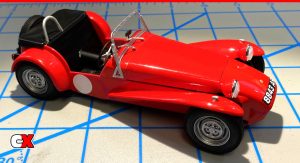 Body
Body
We have to state that Tamiya nailed the body work on the Lotus Super 7! Gorgeous swooping front fenders back to the full rear fenders, a great-looking nose with photo-etched grille, removeable engine cowling, detailed firewall with 3-piece windshield and wipers. Out back, there’s an additional chassis piece that holds the spare tire and, since we went with the road addition, a license plate as well. The license number is duplicated on the front of the car, but in sticker form on the nose. Again, lots of added detail (fender-mounted turn signals, 3-piece headlights and single-piece taillights) that requires patience and steady hands to attach, but the final product is simply stunning! The instructions gave us an option of 2 colors – British Green or Red. The more popular color is the green, so we decided on the red. Obviously.
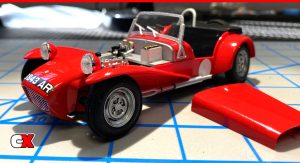 Wheels and Tires
Wheels and Tires
Oddly enough with this version of the kit, the road car and the race car use the same wheels and tires, the only discerning feature being the chrome wheel covers. While we do like the covers, we knew that a hardcore daily-driven race car would be without, so that’s the course we chose. The fronts have pins to attach, the rears clip onto a pin on the rear axle. This is probably our only issue with this kit – the rears. They’re wobbly and the molding isn’t great, so our left rear tire keeps falling off. While we don’t want to, we’re going to have to glue it on to keep it on. Kind of a bummer.
85008 TS-8 Tamiya Italian Red
85009 TS-9 Tamiya British Green
85016 TS-16 Tamiya Yellow
85026 TS-26 Tamiya Pure White
85055 TS-55 Tamiya Dark Blue
81501 X-1 Tamiya Black
81507 X-7 Tamiya Red
81508 X-8 Tamiya Lemon Yellow
81509 X-9 Tamiya Brown
81510 X-10 Tamiya Gunmetal
81511 X-11 Tamiya Chrome Silver
81512 X-12 Tamiya Gold Leaf
81518 X-18 Tamiya Semi-Gloss Black
81527 X-27 Tamiya Clear Red
81701 XF-1 Tamiya Flat Black
81702 XF-2 Tamiya Flat White
81709 XF-9 Tamiya Hull Red
81716 XF-16 Tamiya Flat Aluminum
81724 XF-24 Tamiya Dark Grey
81726 XF-26 Tamiya Deep Green
81753 XF-53 Tamiya Neutral Grey
81756 XF-56 Tamiya Metallic Grey
81759 XF-59 Tamiya Desert Yellow
82118 LP-18 Tamiya Dull Red
Tamiya Extra Thin Cement
Pointed Side Cutters
Decal Scissors
Angled Tweezers
Modeling Knife
Fine Pin Vise
Modeling Brush Set
50-Piece Alligator Clip Painting Stick Set
100-Piece Fine Sanding Twigs
10-Piece Buffing Sticks
Final Thoughts
The Tamiya Lotus Super 7 is a really fun model to build. The kit follows the real car’s basic design with enough detail to assemble something really cool. If you’re a super-modeler, there’s also plenty to add to boost its scale detail – plug and battery wires, for example.
We also love that you can build it one of two ways or, if you’re like us, a nice combination of both.
Just be warned, it is a delicate kit and madly mashing it together certainly won’t produce a display-quality showpiece. Take your time, use kid gloves and you’ll be rewarded with a build you can proudly display in your modeling workshop!
 CompetitionX CompetitionX is the most up-to-date source for RC Car News, Reviews and Videos for Radio Control. We also have the most comprehensive Manual Database on the web.
CompetitionX CompetitionX is the most up-to-date source for RC Car News, Reviews and Videos for Radio Control. We also have the most comprehensive Manual Database on the web.
